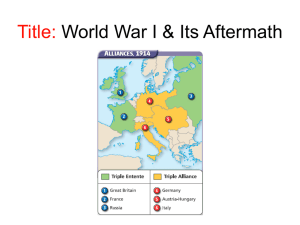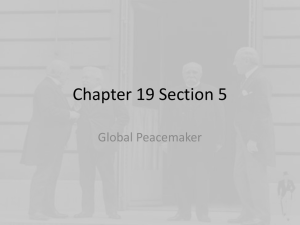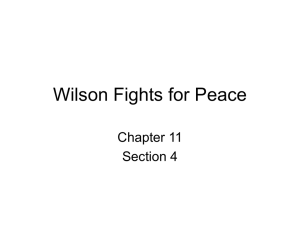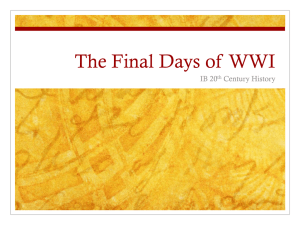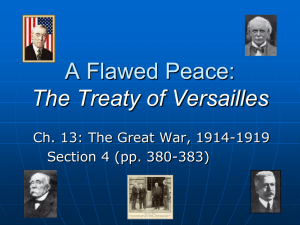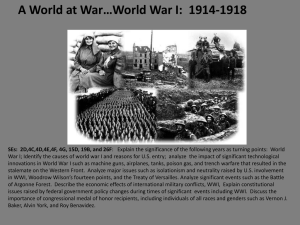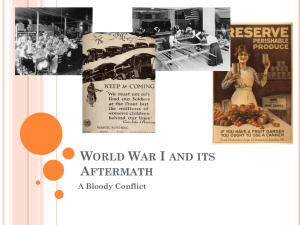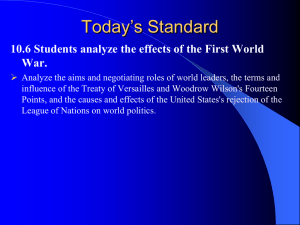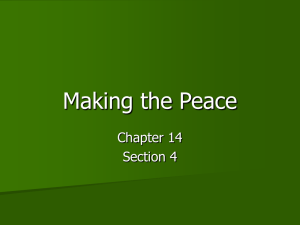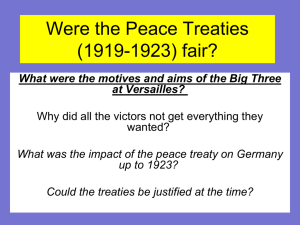ch.11 test
advertisement
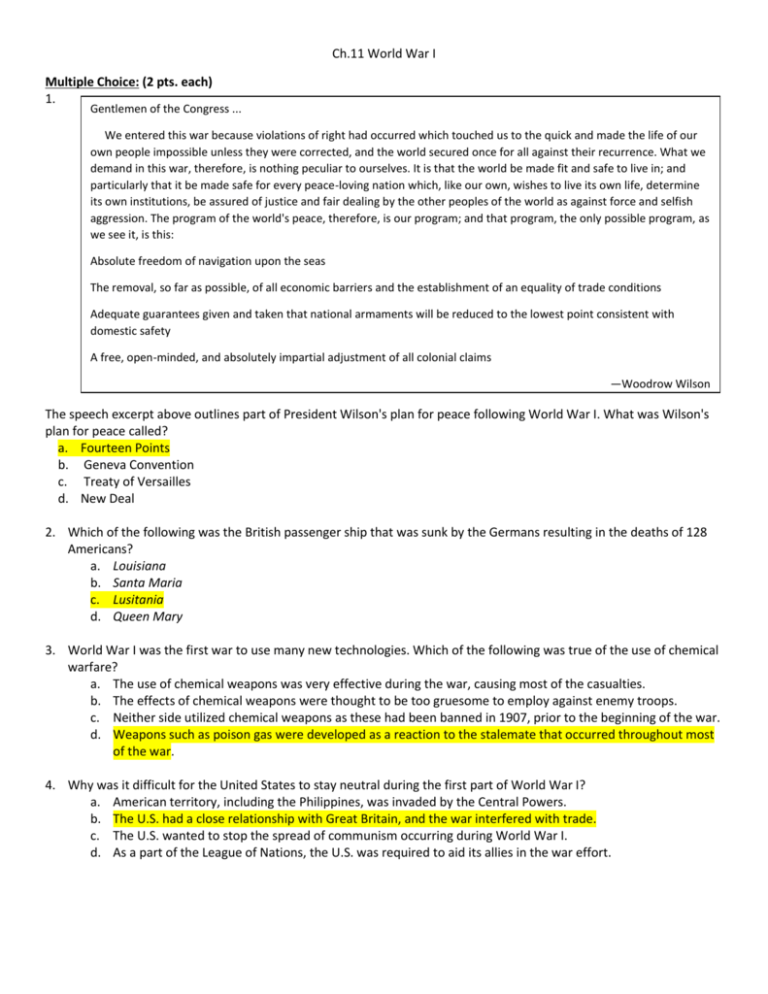
Ch.11 World War I Multiple Choice: (2 pts. each) 1. Gentlemen of the Congress ... We entered this war because violations of right had occurred which touched us to the quick and made the life of our own people impossible unless they were corrected, and the world secured once for all against their recurrence. What we demand in this war, therefore, is nothing peculiar to ourselves. It is that the world be made fit and safe to live in; and particularly that it be made safe for every peace-loving nation which, like our own, wishes to live its own life, determine its own institutions, be assured of justice and fair dealing by the other peoples of the world as against force and selfish aggression. The program of the world's peace, therefore, is our program; and that program, the only possible program, as we see it, is this: Absolute freedom of navigation upon the seas The removal, so far as possible, of all economic barriers and the establishment of an equality of trade conditions Adequate guarantees given and taken that national armaments will be reduced to the lowest point consistent with domestic safety A free, open-minded, and absolutely impartial adjustment of all colonial claims —Woodrow Wilson The speech excerpt above outlines part of President Wilson's plan for peace following World War I. What was Wilson's plan for peace called? a. Fourteen Points b. Geneva Convention c. Treaty of Versailles d. New Deal 2. Which of the following was the British passenger ship that was sunk by the Germans resulting in the deaths of 128 Americans? a. Louisiana b. Santa Maria c. Lusitania d. Queen Mary 3. World War I was the first war to use many new technologies. Which of the following was true of the use of chemical warfare? a. The use of chemical weapons was very effective during the war, causing most of the casualties. b. The effects of chemical weapons were thought to be too gruesome to employ against enemy troops. c. Neither side utilized chemical weapons as these had been banned in 1907, prior to the beginning of the war. d. Weapons such as poison gas were developed as a reaction to the stalemate that occurred throughout most of the war. 4. Why was it difficult for the United States to stay neutral during the first part of World War I? a. American territory, including the Philippines, was invaded by the Central Powers. b. The U.S. had a close relationship with Great Britain, and the war interfered with trade. c. The U.S. wanted to stop the spread of communism occurring during World War I. d. As a part of the League of Nations, the U.S. was required to aid its allies in the war effort. 5. Which of the following was the German war strategy that called for a quick defeat of France before racing East to defeat the Russians? a. Kaiser Plan b. Schlieffen Plan c. Hitler Plan d. Blitzkrieg 6. The world must be made safe for democracy. Its peace must be planted upon the tested foundations of political liberty. We have no selfish ends to serve. We desire no conquest, no dominion. We seek no indemnities for ourselves, no material compensation for the sacrifices we shall freely make. We are but one of the champions of the rights of mankind. We shall be satisfied when those rights have been made as secure as the faith and the freedom of nations can make them. —Woodrow Wilson The quotation above came immediately before which of the following? a. the sinking of the Lusitania by German submarines b. the establishment of the League of Nations c. the bombing of Pearl Harbor by Imperial Japan d. the entry of the United States into World War I 7. Which of the following men was smuggled into Russia by the Germans and eventually led a communist revolution/takeover of Russia in 1917? a. Rick Pitino b. Vladimir Lenin c. Tom Izzo d. Joseph Stalin 8. The picture above from World War I represents which of the following? a. the justification for supporting free trade agreements b. the policy of unrestricted submarine warfare c. the reasons for establishing the League of Nations d. the system of alliances that existed prior to World War 9. A stalemate is a situation in which further action is blocked. The stalemate during World War I was broken in 1917 by a. the collapse of the Russian front. b. the entry of the U.S. into the war. c. the use of chemical weapons. d. the invasion of Normandy 10. One of the contributing factors to America's initial decision to enter into World War I was the Zimmermann Note. What were the contents of this telegram sent from Germany? a. Germany's insistence that the Mexican government refuse to assist the Allies with financial or military aid. b. Germany's threat that upon a Mexican-American alliance, it would no longer engage in trade activities with Mexico. c. Germany's proposal that upon an alliance with Mexico, it would ensure the return of Mexican land lost to the United States. d. Germany's war secrets promised to the Mexican government after the United States entered the war. 11. Beginning in January 1919, delegates from all of the Allied countries met at the Paris Peace Conference to negotiate peace treaties between them and the Central Powers. The Allied powers and Germany signed the Treaty of Versailles. Portions of Germany's prewar territory were taken away. Germany was disarmed and forced to accept an Allied military occupation of the Rhineland. It was required to give up its colonial empire. Germany was forced to accept responsibility for the outbreak of the war. It was required to pay the cost of repairing the wartime damage, known as reparations. Which of the following statements is true about the Treaty of Versailles? a. The Treaty of Versailles created the United Nations. b. The Treaty of Versailles punished Germany. c. The Treaty of Versailles punished Russia. d. The Treaty of Versailles was favorable to Germany. 12. President Woodrow Wilson wanted the United States to participate in a League of Nations. What was the goal of this organization? a. to promote American economic interests b. to finance new industries c. to maintain world peace d. to serve as an international court 13. Which event from the timeline most likely had the biggest impact on German citizens on the home front? a. British naval blockade b. sinking of the Lusitania c. publishing the Zimmermann Telegram d. trench warfare 14. Which of the following identifies a reason why the U.S. chose to side with the Allies during WWI? a. Common ancestry and language b. Similar democratic institutions and legal systems c. Economic ties were stronger d. All of the above 15. The man pictured above is referred to as one of the greatest generals in U.S. military history as he led U.S. infantry forces to victory over the Central Powers during WWI and would later have a major impact on the events in WWII. Who is he? a. George Patton b. Robert E. Lee c. Douglas McArthur d. Jared Brewster 16. Which of the following amendments was passed shortly after the conclusion of WWI and gave women voting rights inside the U.S. for the first time? a. 21st Amendment b. WWI Amendment c. 19th Amendment d. 15th Amendment 17. Why did the United States decide not to participate in the League of Nations established by the Treaty of Versailles at the end of World War I? a. Germany was allowed to be a member nation. b. President Wilson was not in favor of the organization. c. The organization supported Communist expansion in Europe. d. Congress was concerned it would override American interests. 18. The Versailles Treaty established the principle of self-determination, which gives a nation of people the right to decide whether or not they would like to govern themselves. According to the map above, which nation-state was formed following World War I? a. France b. Poland c. Germany d. Greece 19. Which of the following was NOT a new weapon seen on battlefields during WWI? a. Poison Gas b. Tanks c. Atomic Bombs d. Air planes 20. Which of the following was a major change experienced by Europe following WWI? a. Fascists leaders emerged in Italy & Germany b. Communism rose in Russia c. Severe damage to political and social institutions d. All of the above 21. A general association of nations must be formed under specific covenants for the purpose of affording mutual guarantees of political independence and territorial integrity to great and small states alike. —Woodrow Wilson The quotation above comes from Woodrow Wilson's Fourteen Points. This quotation was the fourteenth point and relates directly to which of the following? a. the creation of the League of Nations b. the establishment of an independent Polish state c. the introduction of the policy of self-determination d. the abolition of using warfare to settle international disputes 22. Which of the following was NOT a cause of WWI? a. Imperialism b. Congressionalism c. Militarism d. Alliance Systems 23. According to the map used here, which of the following statements is true regarding the outcome of World War I? a. Country borders following the war were re-drawn to reflect land lost to imperialist policies. b. Disputes regarding territory between Germany and France were finally settled after years of conflict. c. World War I resulted in the dissolution of the German, Austro-Hungarian, and Ottoman Empires. d. All European countries were satisfied with the outcome of the war and the terms of the Treaty of Versailles. 24. Which of the following was a change felt in the U.S. following WWI? a. Military was strengthened exponentially b. Government power was strengthened and expanded c. Accelerated change for women d. All of the above 25. Shortly after World War I ended, some complained that the Versailles Treaty did nothing more than declare a truce for twenty years. Their assumptions proved correct when the unstable peace agreements and cooperation that had been established at the Paris Peace Conference were broken. Although U.S. President Woodrow Wilson had declared that the Great War was "the war to end all wars," in less than twenty years after it began in 1914, many nations had entered a second, devastating conflict. Due to the greater number of casualties, physical destruction, and tragedies, World War II often eclipses the memory of the First World War. According to this excerpt, the Treaty of Versailles a. ensured long-lasting international order. b. was not recognized by most nations. c. proved to be an effective peace agreement. d. created a short-lived, unstable peace 26. During World War I, the War Industries Board was established to shift the United States to a wartime economy. To accomplish this, they fixed prices and wages, set industrial priorities, and converted factories to producing war materials. Over 20 percent of the nation’s production shifted to meet wartime goals. It was a defining moment of federal power; during this time, the government assumed many functions that it continues to have today. Which of these was a short-term result of the War Industries Board? a. The U.S. economy fell into a depression. b. The U.S. economy produced more consumer goods. c. The U.S. economy expanded in production. d. The U.S. economy became more capitalistic. 27. Which nation rejected the Treaty of Versailles, negotiating its own peace agreement with Germany in 1921? a. the Soviet Union b. Japan c. France d. United States 28. The picture above best represents a. the economic hardships on the home front. b. the dangers associated with nuclear warfare. c. the threats of the battlefield during the war. d. the efficiency of aerial bombardment. 29. What term refers to the extremely dangerous zone between the trenches during WWI? a. “No go zone” b. “Demilitarized zone” c. “No man’s land” d. Both A & C 30. During the Paris Peace Conference German representatives were not invited to negotiate on behalf of their country. What Allied country was also not invited to participate in the conference? a. Italy b. Japan c. Great Britain d. Russia 31. The man pictured here was assassinated by a group of extreme Serbian nationalists on June 28, 1914, an event that acted as a trigger to the fighting in World War I. His name was a. Francisco Franco. b. Benito Mussolini. c. Franz Ferdinand. d. Joseph Stalin. 32. The League of Nations called for the break up of the territories of the Ottoman Empire mainly in which of the following regions? a. India b. Southeast Asia c. Middle East d. Eastern Europe 33. This propaganda poster from World War I was most likely saying that a. b. c. d. the war effort would be helped the most if women stayed at home and farmed. women should work in munition plants in support of the war effort. more people should plant their own food in order to help win the war. people should attempt to cut back on how much food they consume daily. 34. Which policy did the United States adopt when World War I first broke out in Europe? a. pacifism b. militarism c. isolationism d. imperialism 35. Which policy did the United States adopt when World War I first broke out in Europe? a. pacifism b. militarism c. isolationism d. imperialism 36. Which of the following is a failure of the Treaty of Versailles? a. War Guilt Clause b. Reparations were unreasonable c. Russian exclusion d. All of the above 37. The man pictured above was a famous American General WWI that was tasked with using tanks to break the stalemate in Europe. Who is he? a. George Patton b. Dwight D. Eisenhower c. Dakota Myer d. Herbert Hoover 38. At the Paris Peace Conference the Allied leaders Woodrow Wilson, George Clemenceau, David Lloyd George, and Vittorio Orlando were referred to as? a. “The Great Appeasers” b. “The Big Four” c. “Masters of War” d. None of the above 39. Which of the following pieces of legislation was passed in May of 1917 to raise an army for the U.S. upon entry into WWI? a. Wilson Draft Act b. Express Draft Proviso c. Selective Service Act d. WWI Registration Act 40. Which of the following was a British naval strategy used to turn the tide submarine warfare against the Germans by protecting merchant ships with Navy destroyers? a. Supremacy of the Seas Policy b. Convoy System c. Caravan System d. Unrestricted Shipping System
